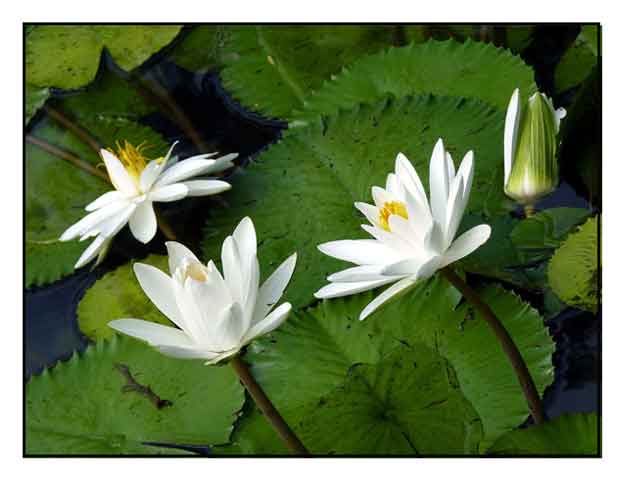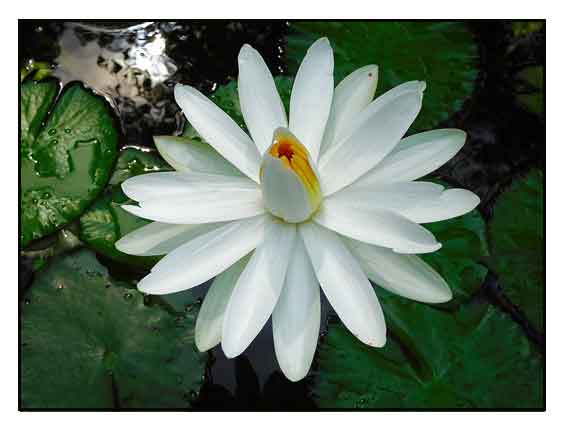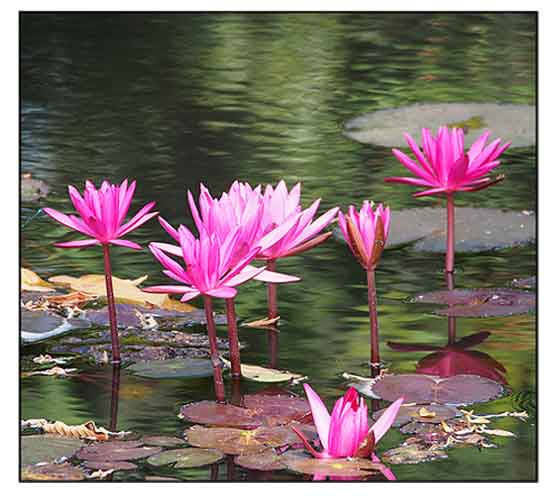 Gen info Gen info
- Nymphaea is a genus of hardy and tender aquatic plants in the Nymphaeaceae family. Plants in the genus are generally referred to as water lilies.
- Taxonomy: It is one of several genera of plants known as lotuses. It is not related to the legume genus Lotus or the Asian or North American lotuses genus of Nelumbo. (27)
- Nymphaea pubescens is a species of water lily.
- Etymology: The genus name Nymphaea derives from Greek nymphia and the Latin nymphaea, which means "water lily", inspired by the nymphs of Greek and Latin mythology.
(27)
-
Nymphaea pubescens is the Official National flower of Bangladesh. (2)
- The plant was published by Carl Ludwig Willdenow in 1799. (2)
 Botany Botany
• Hairy water lily is an aquatic plant with erect perennial rhizomes or rootstocks that anchor to the mud in the bottom. Rhizomes produce slender stolons. Leaf blades are round above water and heart-shaped below. papery, hairy underneath, the stems similarly hairy. While most leaves float on the surface, some leaves rise slightly above water held by their stem in lotus fashion. The floating leaves have wavy edges that give a crenelate effect. Flowers are solitary on long pedicels, large, about 15 cm diameter when fully open, usually close in the daytime and wide open at night. Flower color varies depending on variety or hybrid, ranging from white to pink, mauve or purple. Fruits re spongy berries, globose. Seeds are arillate with both endosperm and perisperm. (2) (15)
• Rhizomes erect, producing slender stolons. Leaf blade ovate-elliptic to suborbicular, 15--26(--50) cm, papery, abaxially densely pubescent, peltate more than 5 mm from base of sinus, base deeply cordate and basal lobes subparallel, margin dentate and teeth acute to subspinose. Flower emergent, (2--)5--8(--15) cm in diam. Calyx insertion on receptacle circular; sepals oblong, 5--8 cm, conspicuously veined, caducous or decaying after anthesis. Petals 12--14(--30), white, red, or pink, oblong, 5--9 cm, transition to stamens abrupt. Filament of inner stamens only slightly wider than anther; connective apically unappendaged. Carpels completely united, walls between locules of ovary single. Stigma rays 12--15(--30); carpellary appendages linear. Fruit ovoid to subglobose, 3.5--5 cm. Seeds ellipsoid to globose, 1--2 mm, with longitudinal ridges. (Flora of China)
Distribution
- Native to the Philippines.
- Also native to Andaman Is., Assam, Bangladesh, Cambodia, China South-Central, East Himalaya, India, Laos, Malaya, Myanmar, New Guinea, Nicobar Is., Northern Territory, Pakistan, Philippines, Queensland, Sri Lanka, Taiwan, Thailand, Vietnam.
- Common in shallow lakes and ponds throughout the temperate and tropical Asia. (2)
- A popular aquarium plant.
 Constituents Constituents
- Ethanolic extract of whole plant yielded flavonoids, alkaloids, tannins, proteins, steroids and phenol with absence of saponins and anthroquinones. (see study below) (9)
- Screening for biomolecules yielded: total chlorophyll 5.54 mg/g, carotenoids 3.11 mg/g,
proteins 348 mg/g, carbohydrates 165 mg/g, lipids 100 mg/g. total phenols 850 mg/ml. (12)
- Phytochemical screening yielded alkaloids, ellagic acid,, phenols,
tannins, saponins, and flavonoids, with absence of of steroids and triterpenoids. (12)
- Study of rhizome extract for total phenolic and flavonoid content yielded 0.48 GAE g/100g. and 0.98 g/100g, respectively. (see study below) (18)
- Proximate composition study of seeds yielded (%) moisture 6.20, ash 3.00, proteins 4.14, lipids 9.28, fiber 5.00 and carbohydrates 78.58. (23)
- Study of amino acid composition of seeds yielded (g/100g) leucine 5.14, lysine 4.88, isoleucine 4.19, phenylalanine 2.39, tryptophan 0.92, valine 3.71, methionine
1.20, arginine 4.47. histidine 2.20, threonine 3.25, cysteine 1.27, proline 3.96, tyrosine 3.10, alanine 3.41, glutamic acid 11.58, glycine 3.94, serine 3.59 and aspartic acid 7.50. (23)
- Preliminary phytochemical screening of
powdered flower parts and alcohol extract yielded alkaloids, carbohydrates, glycosides, phytosterols, tannin and phenolic compounds,and flavanoids (powdered flower only), with absence of fixed oil and fat, saponins, protein and amino acid, mucilage, and lignins. (25)
Properties
- Studies have suggested antidiabetic, hypolipidemic, antioxidant, anti-inflammatory, hepatoprotective, glucuronidase inhibitory, anticancer, antiproliferative, hepatoprotective, glucokinase inhibitory, acethylcholinesterase inhibitory, vasorelaxant, hypotensive, neuroprotective, antimicrobial properties.
Parts used
Roots, leaves, seeds, flowers.
Uses
Edibility
- In northeast Thailand, stalks are eaten raw as a side dish. (10)
- Seeds are reportedly edible.
-In Assam, India, during the flood season when the plant grows profusely in flooded area, the plant becomes a market product. Vhet-laddu is prepared from roasted endosperms.
Also, the rhizomes, peduncles, flowers, and fruits of the plants becomes food fare in the rural communities of Bongaidaon in Assam. (15)
Folkloric
- No reported folkloric medicinal use in the Philippines.
- Elsewhere, various plant parts used for treatment of diabetes, bleeding piles, dyspepsia, jaundice, and eye disorders.
(4)
- In Bangladesh, roots of N. pubescens used with flowers of Hibiscus rosa-sinensis, bark of Ficus religiosa, and seeds of Sesamum indicum as abortifacient, Tribals of Boudh District, Odisha combine rhizomes of N. pubescens with seeds of P. nigrum to make a paste that is applied externally to goiter. Bagdi tribal healers use use leaves, roots, and flowers to treat chronic leucorrhea and the black and foul odor of menstrual blood. Traditional healers of South Orissa use plant rhizomes to treat dysentery, leucorrhea, dysentery, dyspepsia, hemorrhoids and roots to treat burning sensation on urination and menorrhagia, and as abortifacient. (8)
- In Assam, India, powdered rootstock taken orally twice daily for a week for stomach pain caused by acidity. (11)
- In Andhra Pradesh, India, tribes of ViVisakhapatnam District use the plant for various gynecological problems: (1) Flowers with petioles are ground and bandaged on the lower abdomen for bleeding in pregnant women. For leucorrhea, tuber decoction of the white variety is mixed with equal amounts of Mirabilis jalapa and flowers of Thunbergia alata. Also, shade dried powdered pieces of fresh tuber with equal amounts of sugar is administered daily. (3) For menorrhagia, half a cup of fruit juice with a little sugar
is administered daily; or half a cup of flower extract with a little sugar, thrice daily. (24)
- In Sri Lanka, used for treatment of dyspepsia, diarrhea, piles, cystitis, nephritis, eneteritis, fevers, insomnia. Seeds used for diabetes.
- In Siddha medicine, rhizomes used for the treatment of perumpaadu (menorrhagia). (26)
Studies
• Antidiabetic / Whole Plant: Study evaluated the antidiabetic activity of ethanolic extract of whole plant of Nymphaea pubescens. Results showed appreciable α-amylase and α-glucosidase inhibitory effects. Results of invitro study suggest antidiabetic activity. Further studies are suggested to evaluate molecular mechanism and active plant compounds. (4)
• Guggultetrol / Glucokinase Inhibitors: Study evaluated guggultetrol as inhibitor of Glucokinase (PDBID:IV4S) a validated drug target enzyme of type 2 diabetes. In silico molecular docking studies of guggultetrol with Glucokinase enzyme exhibited binding interactions and warrants further studies with potential for the development of potent glucokinase inhibition for treatment of T2DM. (5)
• Hepatoprotective Antioxidant / Anti-Inflammatory / Flowers: In a study of water, methanol, and chloroform extracts of Nymphaea pubescens flowers, the water extract showed most potent free radical scavenging activity with IC50 <100 µg/mL. The water extract also exhibited inhibition of nitrogen radical generation in LPS-activated macrophages (IC5075.5 µg/mL) through suppression of iNOS protein. with no associated toxicity in the cells. It also reduced paw edema after carrageenan administration. It also exhibited hepatoprotective activity on an in-vivo CCl4-induced hepatotoxicity in rats. The hepatoprotective activity was attributed to flavonoids, phenolics, and saponin constituents. (6)
• Anticancer / Apoptosis and Suppression of Cancer Cell Progression: Study evaluated the effect of N. pubescens extracts on cell apoptosis, cellular migration, and invasion through the r0le of antioxidants in B16 melanoma cells. Nymphaea pubescens showed higher capacity for free radical scavenging and higher phenolic than N. stellate. N. pubescens was toxic to B16 melanoma cells. N. pubescens inhibited B16 melanoma cell migration and invasion with low doses. High doses showed a potential of cytotoxicity to induce melanoma cell death.. At low doses the extract showed potential to suppress melanoma cells progression by interfering with both cellular migration and invasion capacity. (7)
• Anti-diabetic / Whole Plant: Study evaluated an ethanolic extract of whole plant for diabetic potential on STZ-induc4d diabetes in wistar albino rats. Acute oral toxicity study of the extract did not produce any mortality or signs of toxicity at dose of 2000 mg/kbw p.o. Results showed a antihyperglycemic effect attributed to the ability to restore the function of pancreatic tissues via increase in insulin output or inhibition of intestinal absorption of glucose or to the facilitation of metabolites in insulin dependent processes. (see constituents above) (9)
• ß-Glucuronidase Inhibitors / Hepatoprotective / Flowers: Study of crude methanol extracts of flowers and pedicels of N. pubescens for hepatoprotective activity by inhibiting the enzyme ß-glucuronidase. GC-MS analyses identified metabolites in the flowers and pedicels (IC50s of 270.7 and 868.46 µg/ml, respectively) which inhibited ß-glucuronidase activity. Fractions showed significantly stronger activity than silymarin. GC-MS analysis of the flower extract and solvent fractions identified kaempferol which showed a 79-fold stronger activity than that of silymarin, Kaempferol showed an IC50 value of 10.44 ± 0.084 µg/ml. (13)
• Antibacterial / Leaves: Study evaluated the antibacterial activity of N. pubescens leaves against human pathogens using diffusion method. The extract high antibacterial activity with inhibition of six Gram-positive bacteria i.e., Bacillus cereus, Staphylococcus aureus , Methicillin resistant S. aureus, an d Enterococcus faecium. There was no inhibition of Gram-negative test bacteria. (14)
• Antiproliferative / Anticancer / Flower: Study evaluated the ethanolic extract of various parts of N. pubescens i.e., leaves, fruits, flower, root and rhizomes for cytotoxic effect against human cervical carcinoma HeLa cell lines and human breast carcinoma MCF-7 cell lines. (16)
• Acetylcholinesterase Inhibitors / Flower: Acetylcholineterase (AChE) inhibitors are used in the treatment of Alzheimer's disease. Screening of edible flowers of N. pubescens showed inhibition of AChE. Study sought to identify the bioactive metabolite(s) responsible for inhibition of AChE. Chemometric analysis showed gallic acid contributed significantly to the inhibition of AChE by the flower extract. Kaempferol, negatively correlated, inhibited AChE. Study suggests a probably synergistic action of metabolites for the AChE inhibitory property of NP flower extracts. (17)
• Antioxidant / Rhizome: Study evaluated the antioxidant activity of various extract of N. pubescens rhizomes for free radical scavenging property using different in vitro models viz., DPPH, hydroxyl superoxide, ABTS, and reducing power, The methanol extract exhibited more potent activity. The in vitro antioxidant activity was compared with standard ascorbic acid/trolox. (see constituents above) (18)
|• Phytol / Anticancer / Leaves: Study evaluated crude extracts of leaves for phytol compound and evaluated it for anticancer effects, antioxidant and anti-inflammatory effects and lethality. All the extracts showed potent inhibition of DPPH, with the methanol extract showing best activity and a potential source of natural antioxidants. The phytol decreased the viability of cells in a dose dependent manner. with an IC50 in MDA MB 231 breast cancer cell line of 160 µg. Results suggest that the phytol of N. pubescens reduces the proliferation and self-renewal ability of actin-positive BCSCs and can be used as a drug for potentially targeting BCSCs. (19)
|• Antihepatotoxic / Acetaminophen Induced Toxicity / Flowers: Study evaluated the antihepatotoxic efficacy of aqueous flower extracts of N . pubescens and silymarin against acetaminophen induced liver damage in rats. Liver damage was evidenced by significant rise in serum levels of AST, ALT, ALP, bilirubin, cholesterol, and decrease in protein level. Antihepatotoxic efficacy was shown by significantly lowered biochemical parameters and increased protein level. (20)
|• Antidiabetic / Hypolipidemic / Antioxidant / Tuber: Study evaluated the possible antidiabetic, hypolipidemic, and antioxidant effects of ethanol extract of N. pubescens tuber in alloxan induced diabetic rats. The extract elicited significant (p<0.05) reductions of blood glucose, lipid parameters except HDL-C, serum enzymes and significantly increased HDL-0C and antioxidant. There was also a significant (p<0.05) increase in plasma insulin. The effects were attributed to its potent antioxidant potential. (21)
|• Antidiabetic / Allipoo Chooranam / Flowers: Study evaluated the antidiabetic activity of Alipoo chooranam, a Siddha herbal preparation of N. pubescens flowers, in STZ-induced diabetic rats. Acute oral toxicity study in normal female Wistar rats per OECD guidelines showed an LD50 of over 2000 mg/kg po. Glibenclamide was used as standard drug. Results showed potent antidiabetic activity. (22)
• Nutritional Potential of Seeds: Study evaluated the nutritional qualities of Nymphaea pubescens and N. lotus seeds. Results suggest that the wild and semi-wild seeds can contribute useful amounts of nutrients to the human diet. (see constituents above) (23)
• Vasorelaxant / Hypotensive: Study evaluated an ethanolic extract of N. pubescens and its main compound, quercetin 3-methyl ether 3'-O-ß-xylopyranoside (compound 1) for its effect on vascular function using isolated mesenteric arteries from Wistar rats. Results showed a vasorelaxant effect of the water lily extract and the main compound, via potentiation of the NO-cAMP pathway and calcium inhibitory effects. The vasorelaxant effects were associated with a potent hypotensive effect, providing pharmacologic support for the traditional use of the plant. (28)
• Neuroprotective against TMT-Induced Cognitive Impairment and Neurodegeneration / Seed: Study evaluated the neuroprotective effects of water lily seed extract on trimethyltin (TMT)-induced cognitive impairment and neurodegeneration in a mouse model. The water lily extract at doses of 100-400 mg/kbw was effective in counteracting the decline in memory and spatial cognition in TMT-induced impairment (p<0.05). At doses of 200 and 400 mg/kbw, the extract substantially lowered MDA level while elevating CAT activity level (p<0.05), and significantly reduced TMT-induced pyramidal cell degeneration in the hippocampus and cerebral cortex (p<0.05). Results suggest potential as a natural anti-neurodegenerative supplement. (29)
• Comparative Total Phenolic Content / Flowers: Study evaluated the total phenolic content in N. nouchali and N. pubescens flower extracts, using aqueous methanol (80%) to extract flowers, including petals, stamens, and pistils. In gallic acid equivalents (GAE)/g dry weight of flower, N. pubescens petals contained 49.78, stamens 37.58, pistil 30.119 GAE/g. Nymphaea pubescens showed higher TPC in every plant part tested compared to N. nouchali, with the petal extract showing highest TPC. (30)
• Antimicrobial / Leaves: Study evaluated the in vitro antimicrogial activity of various extracts of Nymphaea pubescens (pink water lily) leaves against pathogenic bacteria viz. Aeromonas hydrophila, Vibrio parahemolyticus, V. vulnificus, and V. harveyi, which are commonly found in freshwater fish and brackish aquatic animals. The ethnolic extract showed highest bacterial inhibitory effects against V. parahemolyticuus and V. vulnificus. HPLC of phenolic acids group showed gallic acid as most dominant (0.600-3.21% w/w), followed by sinapic acid (0.37-o.83% w/w). In the flavonoids group, catechin was most dominant (0.02-1.08% w/w), followed by rutin (0.002-0.03% w/w). Results suggest potential for use as natural antibiotic to treat bacterial infections in fish and aquatic animals. (31)
Availability
- Wild-crafted.
- Cultivated.
- Seeds in the cybermarket.
- Commercialized as an aquatic plant. |

![]()






